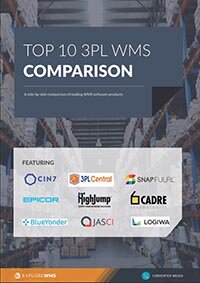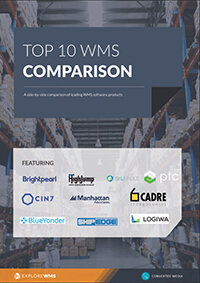3PL WMS selection for 2021: 5 core factors
3PLs have rarely faced as intense and immediate pressure from every partner in their supply chain as most experienced during the early months of the 2020 pandemic. Ocean capacity whipped back and forth, customers tried to sell off stock and time resupplies to avoid holding excess, and manufacturers went offline for weeks at a time. It was a global monkey wrench thrown into the works.
A possible solution to addressing these concerns is to find a smart warehouse management system designed to support you and your customers while providing the flexibility needed to adapt when things change. If you’re making such considerations, there are a few elements that have proven themselves more important than ever.
1. Advanced multichannel fulfillment support
One thing that makes a 3PL an enticing partner is when they can integrate with all of a company’s sales channels and fulfill orders with minimal extra effort. Selling via Facebook, confirming phone orders, and supporting bulk orders don’t feel very different to the seller or their revenue analytics. When outsourcing to a 3PL, they don’t want fulfillment to feel different either.
To ensure that you can meet growing customer demands, looking for warehouse platforms that don’t force any differentiation in these channels. They want you to utilize the same inventory, eliminate the need for excess space or partners, and give them a single dashboard to understand the current stock.
Multichannel fulfillment features make it easier for your customers to run their operations and control costs. The 3PL’s challenge is that new channels keep emerging, and you need to be ready to support them. Look for a WMS that helps you simplify and streamline fulfillment regardless of industry. Even CAT is selling backhoes, dozers, and maintenance packages on Instagram.
Compare 3PL WMS systems in our custom comparison engine
2. Fast partner onboarding
The explosion of ecommerce and large-scale disruption of international manufacturing and fulfillment has led your customers to alter the way they do business dramatically. Many are making split decisions about creating and moving goods, hoping to avoid stockouts while staging products closest to their new customer bases and potential clients.
Part of their partner selection is based on speed. If a 3PL can accommodate a first shipment arriving within a week while another takes twice as long, their sense of urgency will make that choice a simple one. For your WMS selection, consider how long it takes to onboard partners throughout your supply chain:
- Customers
- National carriers
- Local carriers and independent truckers
- Freight forwarders
- Manufacturers
- And more
The faster you can vet, verify, and work with these groups, the better prepared you are to meet changing customer demands.
3. Clear costs and scaling
How much would a WMS cost to implement at your current location with present staff? How does this change if you need to expand to a new location or add three new users? What should you expect to see if you start distributing your inventory to protect against disruptions that the industry faced in 2020?
WMS discussions should focus on the total cost of ownership for the platform and ongoing use but include conversations on how pricing changes if you need to adjust your operations. The way you manage your business and inventory has likely shifted in the past year. 3PLs need to know how this will change their WMS pricing to ensure you’re keeping margins large enough for security and growth.
Here is a special note for readers with distribution operations or partners in Europe who are considering a WMS that’s part of a larger platform, such as an SCM, TMS, or ERP. Ask vendors about any expected changes or increased costs specific to Brexit. Toward the end of 2020, logistics professionals reported greater scrutiny of shipments, delays in customs, and issues with some freight forwarding practices due to the uncertainty of an EU-UK deal. Supply chain software will need to quickly adapt to negotiations and agreements, which may come with a price tag.
4. Modular support to automation
Paper and spreadsheets slow down operations significantly, and you likely outgrew them well before 2020 started. Those processes are full of potential errors and mistakes, especially when a disruption occurs elsewhere. Minimize the risk of error and reduce the burden on your team so they can respond to things like COVID-19 by supporting automation in your data capture and more.
One of the best pathways to automation is with a WMS that has a modular architecture. This setup enables you to configure options for your operations based on what’s available at each distribution location. So, you can have better support for your conveyors and robotics in major hubs while still relying on people for value-add services like kitting and supporting subscription services for your customers.
Ask about the functionality you have installed today and layout your plans for the next few years. If 2020 taught us anything, we need to be looking forward and planning for disruption. Many 3PLs are looking to automation to remove inefficiencies and risk, and that requires support within the WMS.
Check out our guide for shortlisting 3PL WMS vendors
5. Improved data management and real-time visibility
The most advanced features of your WMS will all rely heavily on its ability to manage data and keep your team up to date. For example, cross-docking, especially as a response to COVID-19, requires an immediate understanding of what’s arriving, delayed, and when events two tiers removed could impact these shipments
Look for solutions that make it easy to integrate with your supply chain partners and get updates within a unified dashboard. Support for prioritizing shipments based on turnaround time or the ability to pull items from one order to fill an immediate need is useful when your customers are demanding speed above all else — because they’re not willing to take a loss of accuracy from you.
Analyzing total operations can help you optimize warehouse layouts based on all products, those from specific customers, or even items with specific material handling requirements. Your ability to track, trace, and understand data in the supply chain and your warehouse will enable you to be as dynamic as the market demands.
Ask about existing 3PL customers
It’s tempting to think a shiny new system can save us from the issues that have been occurring. It’s also likely that you’ve heard marketing specific to that effect. Some promise about maintaining up-time and data processing, ensuring order accuracy, or scaling with little effort.
Verify those claims by asking each WMS vendor about existing 3PL customers and how their needs shaped the WMS development. Get recommendations and ask specifically about what matters most to you. If you’re handed a case study, check to see if this company is still a customer of that WMS.
2020 was a year of significant disruptions. Other 3PLs have switched their WMS or are trying options for the first time. Ask about those experiences because a review from 2018 will miss some critical points of the current reality.
Free white paper

Top 10 3PL WMS comparison
Compare the best specialty 3PL WMS solutions

Featured white papers
Related articles
-

What benefits can a 3PL WMS bring to your warehouse?
The key areas where a 3PL WMS can bring benefits to your business
-

Mission-critical features of food lot traceability software
What features of food traceability software will help you during a food recall
-

Guide to shortlisting 3PL WMS vendors
Step-by-step guide to vendor selection during a 3PL WMS project


